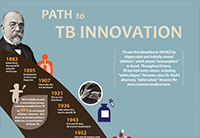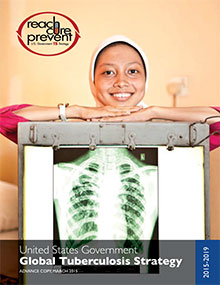- What We Do
- Agriculture and Food Security
- Democracy, Human Rights and Governance
- Economic Growth and Trade
- Education
- Ending Extreme Poverty
- Environment and Global Climate Change
- Gender Equality and Women's Empowerment
- Global Health
- Water and Sanitation
- Working in Crises and Conflict
- U.S. Global Development Lab

Join the Conversation
Follow us on Twitter using #TBFreeWorld and watch the live-streamed event on March 24.
New Strategy
Video

We CAN have a world with zero TB deaths. Watch the animated video on TB, and don’t forget to share and spread the word!
Infographic

View the timeline Path to TB Innovation [PDF, 1.1MB].
Tuberculosis (TB) is an ancient disease that has plagued humankind for centuries. While both preventable and curable, TB remains one of the world’s major causes of illness and death.
TB kills more than 4,100 people each day, with the majority of deaths (95 percent) occurring in low and middle-income countries.
Worldwide, it is estimated that more than 2 billion people are infected with the bacterium that causes TB and are at risk of developing active TB disease.
TB-related deaths and hardships notwithstanding, there has been significant, measurable progress over the last decade and a half. The world is on track to reach the Millennium Development Goals (MDG) target of reversing TB incidence by 2015. Since 1990, the global community has reduced the number of deaths from TB by 45 percent and reduced TB prevalence by 41 percent. Further, since 2000, nearly 37 million people have been successfully treated for TB.
The U.S. Government is a leader in the global fight against TB and the largest bilateral donor in this effort, supporting programs in 26 countries with the highest TB burdens through the U.S. Agency for International Development (USAID).
- In USAID priority countries, deaths from TB decreased by 42 percent since 1990 and the overall prevalence of TB was reduced by 43 percent. These declines in TB prevalence and mortality have contributed significantly to overall global declines.
- In 2013, the most recent year for which complete data are available, more than 2.7 million people with TB were successfully treated and over 60,000 people with MDR-TB were put on treatment with support from USAID. Further, while case notification rates have been stable or declining in recent years globally, case notification has increased in USAID supported countries.
The U.S. Government has a new (2015–2019) long-term strategy to Reach, Cure, and Prevent TB. This strategy will align with the recently approved WHO End TB Strategy and targets. The long-term strategy will focus its efforts and resources on key technical areas, which are vital to effectively addressing the global TB epidemic. The U.S. Government is committed to working with the global community in an effort to reach every person with TB, cure those in need of treatment, and prevent new infections.








Comment
Make a general inquiry or suggest an improvement.